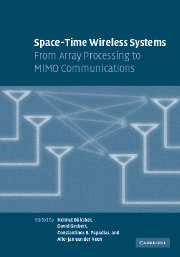Book contents
- Frontmatter
- Contents
- List of contributors
- Acknowledgments
- Introduction
- Part I Multiantenna basics
- Part II Space-time modulation and coding
- 7 Introduction to space-time codes
- 8 Perspectives on the diversity-multiplexing trade-off in MIMO systems
- 9 Linear precoding for MIMO channels
- 10 Space-time coding for noncoherent channels
- 11 Space-time coding for time- and frequency-selective MIMO channels
- Part III Receiver algorithms and parameter estimation
- Part IV System-level issues of multiantenna systems
- Part V Implementations, measurements, prototypes, and standards
- Index
11 - Space-time coding for time- and frequency-selective MIMO channels
Published online by Cambridge University Press: 25 February 2010
- Frontmatter
- Contents
- List of contributors
- Acknowledgments
- Introduction
- Part I Multiantenna basics
- Part II Space-time modulation and coding
- 7 Introduction to space-time codes
- 8 Perspectives on the diversity-multiplexing trade-off in MIMO systems
- 9 Linear precoding for MIMO channels
- 10 Space-time coding for noncoherent channels
- 11 Space-time coding for time- and frequency-selective MIMO channels
- Part III Receiver algorithms and parameter estimation
- Part IV System-level issues of multiantenna systems
- Part V Implementations, measurements, prototypes, and standards
- Index
Summary
Focusing on challenging propagation channels, this chapter discusses spacetime coding techniques utilizing multiple antennas to facilitate high transmission rates, enhanced capacity, and robust system performance in mobile and fading environments.
Multipath and Doppler diversity
High rates come with broadband frequency-selective multipath propagation, while high mobility gives rise to Doppler-induced time-selective fading effects. The combined time-frequency selectivity of the underlying channel induces multipath-Doppler fading, which affects critically communication performance. Capturing multidimensional fading effects (over time, frequency, and space) requires many parameters, making it necessary for the resultant models to cope with the “curse of dimensionality.” Our motivation in this chapter is, at a high-level, to turn this “curse” into a “blessing” by designing multiantenna systems capable of collecting the embedded joint multipath- Doppler-spatial diversity gains. But before tackling this design goal, it is important to understand and quantify these diversity gains emerging from time- and frequency-selective propagation.
Frequency-selective channels and multipath diversity In their wireless propagation, the emitted signal waveforms may be reflected or diffracted, before reaching the receiver through different paths–a manifestation of what is known as multipath propagation. Due to the finite speed of light, the multiple paths conveying the information content travel variable distances and arrive at the receiver at different times. This causes time dispersion of the transmitted waveforms, which is known as delay spread. As a result, each symbol spills over adjacent symbols and gives rise to so-called intersymbol interference (ISI). In this case, we say that the channel exhibits frequency selectivity.
- Type
- Chapter
- Information
- Space-Time Wireless SystemsFrom Array Processing to MIMO Communications, pp. 218 - 238Publisher: Cambridge University PressPrint publication year: 2006
- 1
- Cited by



